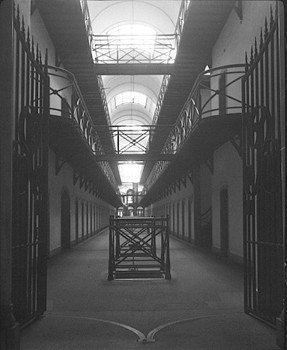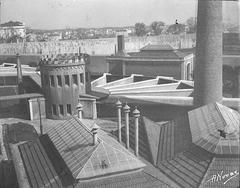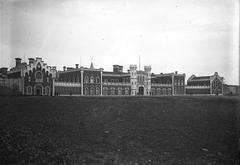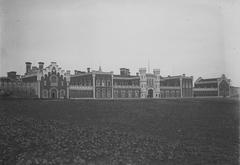
Estabelecimento Prisional de Lisboa: Visiting Hours, Accessibility, and Travel Guide
Date: 15/06/2025
Introduction
The Estabelecimento Prisional de Lisboa (EPL), located in the heart of the Portuguese capital, is far more than a correctional facility—it is a landmark that encapsulates Portugal’s evolution in penal philosophy, architecture, and urban development. Built between 1873 and 1885, EPL’s star-shaped, panopticon-inspired design and its prominent place in Lisbon’s social and political history have made it a subject of ongoing public interest. As of 2025, EPL is in the final stages of closure, a process driven by deteriorating conditions and national efforts toward more humane and modern correctional approaches (DGRSP; AURA Real Estate News).
This comprehensive guide details EPL’s historical and architectural significance, the realities of visitor access, alternative ways to engage with Lisbon’s justice heritage, practical information for families and legal professionals, and recommendations for exploring nearby cultural sites.
Historical Significance and Architectural Features
A Model of 19th-Century Penal Reform
EPL was conceived in the context of sweeping penal reforms, influenced by Enlightenment ideals and the abolition of the death penalty in Portugal in 1867 (DGRSP). Its construction, overseen by engineers Joaquim Júlio Pereira de Carvalho, Luís Victor Le Cocq, and Ricardo Júlio Ferraz, was both a technological and political milestone, introducing progressive concepts such as surveillance for rehabilitation rather than punishment (repositorio.ulisboa.pt).
Panopticon Design and Innovations
EPL’s panopticon-inspired radial plan—with six wings radiating from a central observation hub—allowed guards to oversee multiple corridors efficiently (prisonphotoproject.pt). The use of steel and glass, stained-glass windows, Christian and Masonic iconography, and innovative use of space set new standards in prison architecture (repositorio.ulisboa.pt).
Over time, the facility expanded to include workshops, a school, gymnasium, and therapeutic units, reflecting Portugal’s commitment to inmate rehabilitation (restosdecoleccao).
EPL’s Place in Lisbon’s Urban and Social Tapestry
Originally built on the city’s outskirts, EPL now stands amidst central Lisbon, near Parque Eduardo VII and major neighborhoods. Its imposing walls have long symbolized the boundary between incarceration and city life, while its presence has shaped local employment and social policy discussions (restosdecoleccao; Expresso).
Current Status: Closure and Accessibility
Final Phases of Decommissioning
By June 2025, EPL is in the process of being decommissioned, with all inmates scheduled for transfer by 2026 due to overcrowding, poor hygiene, and international scrutiny (SIC Notícias; Observador). The closure is part of a national strategy to replace outdated facilities and reinforce a rehabilitative model (Justice Trends).
Visitor Access: Restrictions and Procedures
- Public Access: EPL is not open to the public. There are no regular visiting hours or tickets available for tourists or casual visitors.
- Authorized Visits: Only pre-approved family members, legal representatives, and professionals with official business may enter. All visits require prior scheduling and are subject to strict security protocols (LadoF).
- Photography: Photography inside or of inmates is strictly prohibited to protect privacy and security. Exterior images may be taken from public areas with respect to regulations.
How to Reach EPL (For Authorized Visitors)
- Address: Rua Marquês da Fronteira, n.º 54, 1099-011 Lisboa
- Metro: São Sebastião (Blue and Red lines) – 10-minute walk
- Bus: Multiple lines serve the area
- Parking: Limited on-site and street parking
Contact
- Phone: See official sites for the most current contact number
- Email: Use official channels for visit requests or information (LadoF)
Ethical and Safety Considerations
Why EPL Is Not Open for Tourism
EPL has been the focus of international criticism due to overcrowding, unsanitary conditions, and credible allegations of mistreatment (SIC Notícias). To avoid trivializing the suffering of inmates and to uphold human dignity, EPL does not permit general visits or guided tours. All entry is for functional, not entertainment, purposes.
Security Protocols
Visitors must submit identification, undergo searches, and comply with all institutional rules. Bringing unauthorized items or failing to observe conduct standards may lead to denial of entry or legal consequences.
Facility Conditions
The prison remains overcrowded and under-resourced, with known issues regarding hygiene, lighting, and general maintenance (Observador). These realities further justify the closure and strict access limitations.
Alternative Ways to Engage with Lisbon’s Penal and Urban History
Although EPL itself is not open to the public, Lisbon offers rich opportunities for those interested in justice history, architecture, and cultural heritage:
- Guided Walking Tours: Explore historic districts like Alfama and Baixa, often featuring insights into Lisbon’s penal history (Essencial Portugal).
- Museums & Exhibitions: Visit the Museu de Lisboa or themed exhibitions for context on the city’s evolution.
- Photographic Projects: The Prison Photo Project provides visual documentation of Portuguese prison history.
- Literature: Books such as Álvaro Cunhal’s “A Estrela de Seis Pontas” were inspired by EPL’s narrative.
- Heritage Events: Occasionally, heritage days or academic initiatives may offer limited, supervised EPL access—check with local heritage organizations for updates.
Frequently Asked Questions (FAQ)
Q: Is EPL open for tourists or casual visits?
A: No. EPL is closed to the public. Access is strictly limited to authorized visitors.
Q: Are there guided tours or tickets available?
A: No regular tours or tickets are available due to privacy, ethical, and security reasons.
Q: How can I arrange a legal or family visit?
A: Contact the prison administration in advance, providing the inmate’s details and all required documentation. Visits are scheduled and supervised.
Q: What are some nearby attractions for those interested in Lisbon’s history?
A: Explore Belém Tower, Jerónimos Monastery, MAAT, Alfama, and Baixa, all of which provide access to Lisbon’s rich heritage.
Q: What is planned for the future of the EPL site?
A: The site will be redeveloped, with plans for university residences, a justice campus, and potential mixed-use public spaces (AURA Real Estate News).
Summary Table: Key Information
| Aspect | Details |
|---|---|
| Location | Rua Marquês da Fronteira, n.º 54, Lisbon |
| Capacity (2022) | 1,043 inmates (156 above official limit) |
| Scheduled Closure | 2026 |
| Visit Eligibility | Authorized family, legal representatives, professionals only |
| Public Access | Not permitted |
| Facility Condition | Overcrowded, poor hygiene, maintenance issues, allegations of abuse |
| Redevelopment Plans | University residences, Justice Campus, public spaces |
| Contact Channels | Phone, email, in-person (with prior approval) |
| Alternatives | Museums, exhibitions, walking tours, photographic projects |
Call to Action
While direct visitation to EPL is not possible, Lisbon’s living history is accessible through its museums, walking tours, and cultural venues. For updates on heritage events, justice system reforms, and curated travel tips, download the Audiala app or follow reputable local news and tourism resources. Scholars and visitors alike are encouraged to respect the dignity of those connected to EPL and engage with Lisbon’s penal legacy through informed, ethical, and culturally sensitive means.
Sources and Further Reading
- DGRSP – Estabelecimento Prisional de Lisboa
- AURA Real Estate News
- Repositório Universidade de Lisboa
- Expresso
- Essencial Portugal
- Justice Trends
- Observador
- SIC Notícias
- GoWithGuide
- LadoF
- Prison Photo Project
- restosdecoleccao
- Audiala app





























































